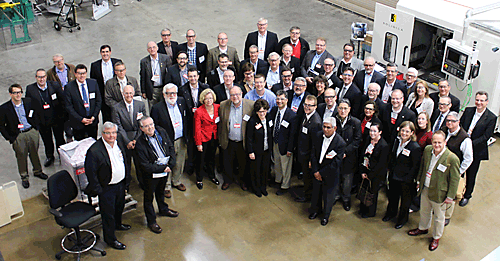 |
||||||||
| December 19, 2012 | ||||||||
| SealMax seals save money |  |
|||||||
| ˇ www.tappi.org ˇ Subscribe to Ahead of the Curve ˇ Newsletters ˇ Ahead of the Curve archived issues ˇ Contact the Editor |
Top International Research Managers Gather in Knoxville Almost any gathering of
professionals in the forest products industry eventually gets around to
discussing the need for industry transformation. The decline of newspapers
and the rise of tablets and Smart phones, emerging markets, and growth
in developing countries have many wondering what is next for our industry.
It is obvious that transformation is needed to carry this industry
into the coming decades, and that technology will help us get there.
But how to select the right R&D projects?
A TAPPI committee--the International Research Management Committee
(IRMC)--is working to this end. Made up of research leaders from forest
products companies, supplier companies, research centers, and universities
from around the globe, its mission is to enhance R&D management within
the industry.
Following are some of the committee's recent activities.
A VISIT TO OAK RIDGE NATIONAL LABS The meeting began with a visit to Tennessee's Oak Ridge National Laboratory
(ORNL). With a $1.6 billion research budget, ORNL is packed with advanced
technology and equipment and renowned technical experts. Jeff Cornett,
Manager of Industrial Partnerships & Economic Development, explained
that ORNL focuses on helping businesses solve problems and encouraged
participants to reach out to the more than 4000 scientists at the facility.
Dr. Michelle Buchanan, Associate Director of Physical Sciences, gave
an overview of the lab's core competencies, and Dr. Paul Gilna, Director
of ORNL's BioEnergy Science Center, provided an update on the center's
work in developing biofuels from cellulosic biomass.
An exciting part of the program was an update on lignin-based carbon
fibers led by Tom Rogers, ORNL's Director of Industrial Partnerships,
who said that ORNL's goal is to develop a product within five years.
The Carbon Fiber Composites Consortium, with more than 40 members, has
established a lignin working group that is actively contributing to
the project.
The day concluded with a brief tour of the Additive Manufacturing demonstration
facility and its 3-D printing work in designing and manufacturing components.
Computer models are generated, and material is then laid down in a layer-by-layer
process.
ORNL's capabilities and technologies also include three Nexterra wood
gasifiers and scientists open to collaboration. Members of IRMC recommended
that meeting attendees learn more about ORNL by visiting www.ornl.gov
and signing up for its newsletter--the ORNL Review.
THE FUTURE OF PAPER Dr. Ted Farrington, Senior Research Director with Pepsico Advanced
Research, presented a fascinating talk on the Research Foresights tool
which uses strategic foresight methods to influence breakthroughs in
innovation agendas. He described how this process was used within Pepsico
and how the Industrial Research Institute is using this same process
to determine how the art and science of research and technology management
will change over the next 25 years. Visit www.iriweb.org to learn more
about the Industrial Research Institute.
SHARING CHALLENGES "We are excited about the growth we have had in committee membership
and look for it to continue," said IRMC Committee Chairman Dr. Gil Garnier,
Director of the Australian Pulp and Paper Institute at Monash University.
AGENDA 2020 REVIEWS R&D PRIORITIES Agenda 2020's participation was cited as a critical success factor
in the DOE funding of a $2.6 million research project to develop sacrificial
coatings for membrane-based concentration of weak black liquor. If successful,
the technology could be an alternative for the first two evaporator
stages.
Responses to government requests for information from Agenda 2020,
presented industry perspectives in regard to the proposed $1 billion
National Network for Manufacturing Innovation and the DOE Biomass roadmap
for conversion technologies for advanced biofuels. Both entries can
be viewed online by visiting: www.agenda2020.org.
Recently, USDA Secretary Tom Vilsack requested information on opportunities
for the U.S. government to support development of nanocellulose applications.
Agenda 2020's response outlined a plan for a national R&D program. Federal
leaders are suggesting inter-departmental/inter-industry executive briefings
to highlight the commercial potential for nanocellulose.
The Knoxville meeting included a review of the industry's evolving
research priorities. Members and guests also acknowledged the need to
increase the visibility of the industry's research needs as well as
the emerging areas of investigation at research institutions, including
government labs and agencies, to attract scientists and funding to industry
opportunities.
Several opportunities emerged to increase international research collaboration
on pre-competitive topics in the industry. One, for example, involves
the European COST Action 1150, featuring working groups undertaking
fundamental studies of the cell physics in tree growth; impacts of cell
structures on pulping, bleaching, and papermaking processes; and mechanisms
of biopolymer self-assembly processes. The president of a European research
institute commented on the similarity of working with government funding
agencies in the U.S. and Europe.
Colleen Walker, Ph.D., is Project Manager and Technical Lead, TAPPI,
and can be contacted at cwalker@tappi.org.
Now that you
are Ahead of the Curve, stay there by joining TAPPI. |
|||||||
 |
||||||||



